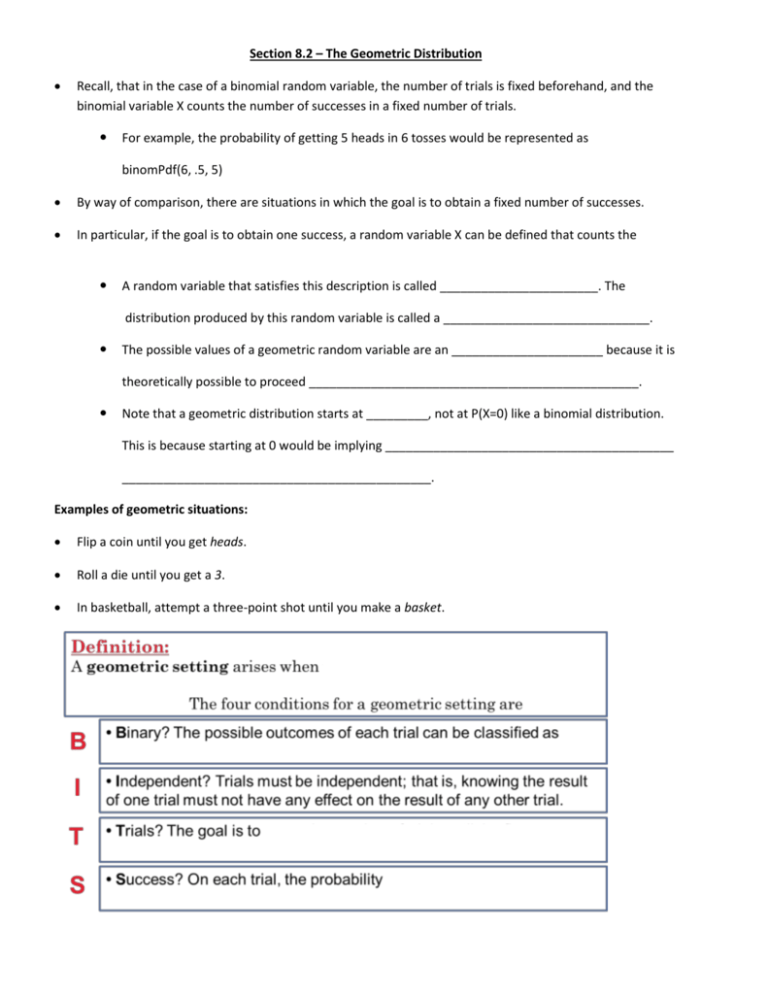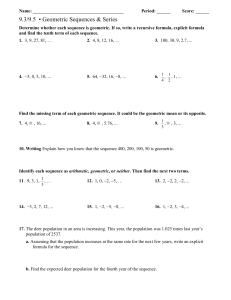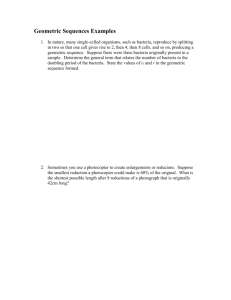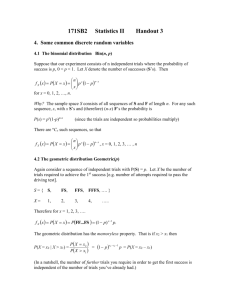Sec. 8.2 Blank Notes
advertisement

Section 8.2 – The Geometric Distribution Recall, that in the case of a binomial random variable, the number of trials is fixed beforehand, and the binomial variable X counts the number of successes in a fixed number of trials. For example, the probability of getting 5 heads in 6 tosses would be represented as binomPdf(6, .5, 5) By way of comparison, there are situations in which the goal is to obtain a fixed number of successes. In particular, if the goal is to obtain one success, a random variable X can be defined that counts the number of trials needed to obtain that first success. A random variable that satisfies this description is called _______________________. The distribution produced by this random variable is called a ______________________________. The possible values of a geometric random variable are an ______________________ because it is theoretically possible to proceed ________________________________________________. Note that a geometric distribution starts at _________, not at P(X=0) like a binomial distribution. This is because starting at 0 would be implying __________________________________________ _____________________________________________. Examples of geometric situations: Flip a coin until you get heads. Roll a die until you get a 3. In basketball, attempt a three-point shot until you make a basket. Example 8.15 – Roll a die Suppose you roll a die repeatedly until you get a 3. Is this a geometric setting? The event of interest is rolling a 3 so this would be binary (success/failure) Each toss is independent of the others The random variable is defined as X = the number of trials until a 3 occurs The probability of success is the same for each toss This is a geometric setting since all the conditions were met See example 8.15 on p.465 for further explanation Example 8.16 – Draw an Ace Suppose you repeatedly draw cards without replacement from a deck of 52 cards until you draw an ace. Is this a geometric setting? The event of interest is drawing an ace so this is binary (success/failure) The draws would not be independent because you do not replace the previous draw This is not a geometric setting since the draws are not independent. See example 8.16 on p.465 for further explanation. Rules for Calculating Geometric Probabilities Using example 8.16, P(X = 1) = P(success on 1st roll) = 1/6 P(X = 2) = P(success on 2nd roll) = (5/6)(1/6) P(X = 3) = P(success on 3rd roll) = (5/6)(5/6)(1/6) In general, this can be modeled as: Geometric Distribution Graph The following is a graph of the geometric distribution that represents the probability of a success after X of rolls. Geometric distributions will always be ______________________________ since each time a trial goes by without a success you are multiplying by a number _______________________________________. The Expected Value and Other Properties of the Geometric Random Variable If you flip a fair coin, how many times would you expect to have to flip it to observe the first head? 2 times If you are rolling a die, how many times would you expect to have to roll it to observe your first 3? 6 times Example 8.18 Glenn likes the game at the state fair where you toss a coin into a saucer. Glenn has played this game many times and has determined that on average he wins 1 out of every 12 times he plays. He believes his chances for winning are the same each time and has no reason to believe that the tosses are not independent. Let X be the number of tosses until a win. Determine the mean and standard deviation. 𝜇𝑋 = 1 1 12 = 12 “More” Than a Certain Number of Trials Suppose you are interested in knowing the probability that it takes more than a certain number of trials to achieve success. For example, the probability that it takes more than 5 tosses to land on a head. The probability that it takes more than n trials to see the first success is: 𝑃(𝑋 > 𝑛) = (1 − 𝑝)𝑛 Refer to p.470 if interested in how the formula is derived Example 8.19 – Applying the Formula What is the probability that it takes more than 6 rolls to observe a 3? 1 5 𝑃(𝑋 > 6) = (1 − 6)6 = (6)6 ≈ .335 What is the probability that it takes more than 12 tosses to land the coin in the saucer? 1 11 𝑃(𝑋 > 12) = (1 − 12)12 = (12)12 ≈ .352 Refer to p.471-472 for calculator commands (steps 1 & 4) regarding geometric distributions.









